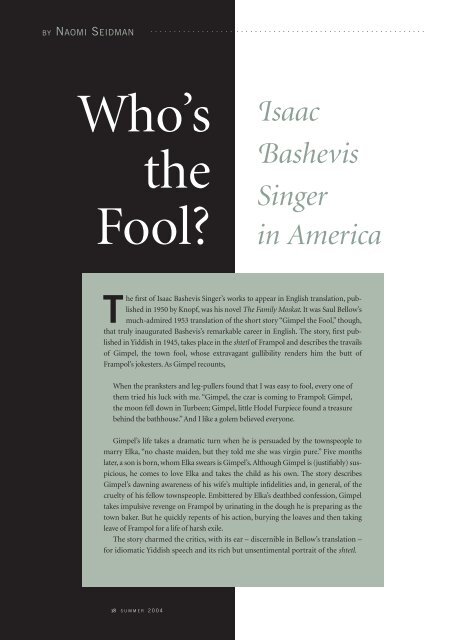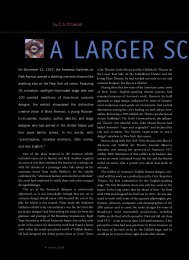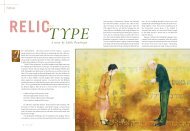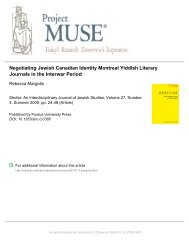Who's the Fool?: Isaac Bashevis Singer in America - Yiddish Book ...
Who's the Fool?: Isaac Bashevis Singer in America - Yiddish Book ...
Who's the Fool?: Isaac Bashevis Singer in America - Yiddish Book ...
You also want an ePaper? Increase the reach of your titles
YUMPU automatically turns print PDFs into web optimized ePapers that Google loves.
BY NAOMI SEIDMANWho’s<strong>the</strong><strong>Fool</strong>?<strong>Isaac</strong><strong>Bashevis</strong><strong>S<strong>in</strong>ger</strong><strong>in</strong> <strong>America</strong>The first of <strong>Isaac</strong> <strong>Bashevis</strong> <strong>S<strong>in</strong>ger</strong>’s works to appear <strong>in</strong> English translation, published<strong>in</strong> 1950 by Knopf, was his novel The Family Moskat. It was Saul Bellow’smuch-admired 1953 translation of <strong>the</strong> short story “Gimpel <strong>the</strong> <strong>Fool</strong>,” though,that truly <strong>in</strong>augurated <strong>Bashevis</strong>’s remarkable career <strong>in</strong> English. The story, first published<strong>in</strong> <strong>Yiddish</strong> <strong>in</strong> 1945, takes place <strong>in</strong> <strong>the</strong> shtetl of Frampol and describes <strong>the</strong> travailsof Gimpel, <strong>the</strong> town fool, whose extravagant gullibility renders him <strong>the</strong> butt ofFrampol’s jokesters. As Gimpel recounts,When <strong>the</strong> pranksters and leg-pullers found that I was easy to fool, every one of<strong>the</strong>m tried his luck with me. “Gimpel, <strong>the</strong> czar is com<strong>in</strong>g to Frampol; Gimpel,<strong>the</strong> moon fell down <strong>in</strong> Turbeen; Gimpel, little Hodel Furpiece found a treasurebeh<strong>in</strong>d <strong>the</strong> bathhouse.” And I like a golem believed everyone.Gimpel’s life takes a dramatic turn when he is persuaded by <strong>the</strong> townspeople tomarry Elka, “no chaste maiden, but <strong>the</strong>y told me she was virg<strong>in</strong> pure.” Five monthslater, a son is born, whom Elka swears is Gimpel’s. Although Gimpel is (justifiably) suspicious,he comes to love Elka and takes <strong>the</strong> child as his own. The story describesGimpel’s dawn<strong>in</strong>g awareness of his wife’s multiple <strong>in</strong>fidelities and, <strong>in</strong> general, of <strong>the</strong>cruelty of his fellow townspeople. Embittered by Elka’s deathbed confession, Gimpeltakes impulsive revenge on Frampol by ur<strong>in</strong>at<strong>in</strong>g <strong>in</strong> <strong>the</strong> dough he is prepar<strong>in</strong>g as <strong>the</strong>town baker. But he quickly repents of his action, bury<strong>in</strong>g <strong>the</strong> loaves and <strong>the</strong>n tak<strong>in</strong>gleave of Frampol for a life of harsh exile.The story charmed <strong>the</strong> critics, with its ear – discernible <strong>in</strong> Bellow’s translation –for idiomatic <strong>Yiddish</strong> speech and its rich but unsentimental portrait of <strong>the</strong> shtetl.18 SUMMER 2004
In <strong>the</strong> <strong>America</strong>n literary arena of <strong>the</strong> 1950s, <strong>Bashevis</strong>’snarrative world was still utterly exotic; as one reviewer putit, Bellow’s English version of <strong>Bashevis</strong> captured “<strong>the</strong> barbaric,oriental flavor that one associates with EasternJews.” With <strong>the</strong> appearance of Irv<strong>in</strong>g Howe and EliezerGreenberg’s Treasury of <strong>Yiddish</strong> Stories, <strong>in</strong> which “Gimpel<strong>the</strong> <strong>Fool</strong>” was featured, Sidra DeKoven Ezrahi writes,“1953 becomes <strong>the</strong> year that <strong>in</strong>augurates <strong>the</strong> <strong>America</strong>nattempt to reclaim a lost Jewish place and a severed Jewishstory.” Sensitive critics realized that “Gimpel <strong>the</strong> <strong>Fool</strong>” wasnot only ethnographical portraiture, it was also modernistliterature. As “simple” as Gimpel is, he is also a complexand fully realized character, both thoroughly immersed <strong>in</strong>his traditional milieu and isolated from <strong>the</strong> ma<strong>in</strong> currentsof its community life.All agreed that Bellow’s translation was a masterpiece,present<strong>in</strong>g a voice <strong>in</strong> English that was both new and thatseemed, somehow, to have always been <strong>the</strong>re. Bellow hadnot only brought <strong>Bashevis</strong>’s <strong>Yiddish</strong> <strong>in</strong>to literary English,he had also succeeded <strong>in</strong> fashion<strong>in</strong>g a <strong>Yiddish</strong>-<strong>in</strong>fusedEnglish utterly removed from <strong>the</strong> “coarse” immigrantspeech with which <strong>Yiddish</strong> had previously been associated.DeKoven Ezrahi and o<strong>the</strong>r critics have suggested thathowever great <strong>the</strong> debt <strong>Bashevis</strong> owed to Bellow for<strong>in</strong>troduc<strong>in</strong>g him to <strong>the</strong> world of English letters,Bellow’s own subsequent style was at least asbeholden to <strong>Bashevis</strong>’s <strong>Yiddish</strong> idiom.As with all translations, however, <strong>the</strong>rewere also measurable losses: ChoneShmeruk and Anita Norich have (separately)drawn attention to <strong>the</strong> level<strong>in</strong>g, <strong>in</strong><strong>the</strong> English, of <strong>the</strong> <strong>Yiddish</strong> story’s very firstl<strong>in</strong>es. While <strong>the</strong> <strong>Yiddish</strong> beg<strong>in</strong>s: “Ich b<strong>in</strong>Gimpel tam. Ich halt mikh nisht far keynnar,” Bellow rendered <strong>the</strong> two dist<strong>in</strong>ctterms “tam” and “nar” with formsof <strong>the</strong> word “fool”: “I am Gimpel<strong>the</strong> fool. I don’t consider myselffoolish.” Tam,ofHebrew derivation,means someth<strong>in</strong>g like“simple” or “<strong>in</strong>nocent” (familiar as<strong>the</strong> third of “<strong>the</strong> four sons” <strong>in</strong> <strong>the</strong>Passover Haggadah). The German-derived“nar,” by contrast, lacks any positive connotationsand more simply refers to a fool. Perhaps unavoidably, <strong>the</strong>English fails to register fully <strong>the</strong> difference between <strong>the</strong>“tam” Gimpel acknowledges as part of his name and <strong>the</strong>“nar” he denies that he is. With <strong>the</strong> publication of <strong>the</strong>German translation of <strong>the</strong> story <strong>in</strong> 1968, entitled “Gimpelder Narr,” <strong>the</strong> difference between foolishness and simplicityso crucial to <strong>the</strong> story’s <strong>Yiddish</strong> open<strong>in</strong>g was completelyforgotten. Gimpel was, <strong>the</strong> title asserted, exactlywhat <strong>the</strong> townspeople considered him – a Narr.Ano<strong>the</strong>r serious translation loss <strong>in</strong> Bellow’s version wasless often discussed by <strong>the</strong> critics. As Janet Hadda’s biographyof <strong>Bashevis</strong> recounts, <strong>the</strong> translation also elidedwhat Hadda calls “<strong>the</strong> anti-Christian references” <strong>in</strong>“Gimpel <strong>the</strong> <strong>Fool</strong>.” While <strong>the</strong> translation problem oftam /nar rested primarily on l<strong>in</strong>guistic difficulties – asNorich po<strong>in</strong>ts out, “Gimpel <strong>the</strong> Simple” would have <strong>in</strong>troducedan <strong>in</strong>appropriate rhyme – <strong>the</strong> issues <strong>in</strong>volved <strong>in</strong>translat<strong>in</strong>g <strong>Bashevis</strong>’s references to Christianity were
a<strong>the</strong>r a matter of cultural politics. Hadda describes how<strong>the</strong>se passages were censored. As it turns out, it was notBellow, but Eliezer Greenberg, <strong>Bashevis</strong>’s European-borneditor and friend, who was responsible:[T]he real break for <strong>Bashevis</strong>, his <strong>in</strong>troductionto <strong>America</strong>n readers who could appreciate him,was <strong>the</strong> 1953 appearance, <strong>in</strong> <strong>the</strong> prestigiousPartisan Review, of “Gimpel <strong>the</strong> <strong>Fool</strong>,” masterfullytranslated by Saul Bellow. Although not Europeanborn,Bellow was ideally suited to render <strong>Bashevis</strong><strong>in</strong>to English for a cosmopolitan audience.…None<strong>the</strong>less, he was at first reluctant to undertake<strong>the</strong> assignment. Approached by Eliezer Greenberg,Bellow <strong>in</strong>itially decl<strong>in</strong>ed. He was teach<strong>in</strong>g atPr<strong>in</strong>ceton University and f<strong>in</strong>ish<strong>in</strong>g his novel, TheAdventures of Augie March. He simply didn’t have<strong>the</strong> time, he told Greenberg. But Greenberg,undeterred, suggested he could come to Bellowand read <strong>the</strong> <strong>Yiddish</strong> to him; Bellow couldtranslate right onto <strong>the</strong> typewriter.And so it was – which allowed Greenberg toexercise a bit of deception. He omitted <strong>the</strong> overtanti-Christian references conta<strong>in</strong>ed <strong>in</strong> <strong>the</strong><strong>Yiddish</strong> orig<strong>in</strong>al.Hadda doesn’t list <strong>the</strong> anti-Christian omissions of <strong>the</strong>translation, but <strong>the</strong>y are easily gleaned from a comparisonof <strong>the</strong> two versions. Two are brief references to Elka, compar<strong>in</strong>gher first, <strong>in</strong> appearance, to a shiksa and <strong>the</strong>n, <strong>in</strong> herswear<strong>in</strong>g, to a goy. But <strong>the</strong> third and longest reference ismost strik<strong>in</strong>g. Greenberg omitted an entire l<strong>in</strong>e, <strong>the</strong> f<strong>in</strong>alone, from a scene that beg<strong>in</strong>s with Gimpel’s confrontationof his wife, who has given birth suspiciously soon after<strong>the</strong>ir wedd<strong>in</strong>g. In Bellow’s version:“How can he be m<strong>in</strong>e?” I argued. “He was bornseventeen weeks after <strong>the</strong> marriage.” She told me<strong>the</strong>n that he was premature. I said, “Isn’t he a littletoo premature?” She said, she had had a grandmo<strong>the</strong>rwho carried just as short a time and sheresembled this grandmo<strong>the</strong>r of hers as one drop ofwater does ano<strong>the</strong>r. She swore to it with such oathsthat you would have believed a peasant at <strong>the</strong> fair ifhe had used <strong>the</strong>m. To tell <strong>the</strong> pla<strong>in</strong> truth, I didn’tbelieve her; but when I talked it over next day with<strong>the</strong> schoolmaster, he told me that <strong>the</strong> very sameth<strong>in</strong>g had happened to Adam and Eve. Two <strong>the</strong>ywent up to bed, and four <strong>the</strong>y descended.“There isn’t a woman <strong>in</strong> <strong>the</strong> world who is not <strong>the</strong>granddaughter of Eve,” he said.That was how it was; <strong>the</strong>y argued me dumb. But<strong>the</strong>n, who really knows how such th<strong>in</strong>gs are?While <strong>the</strong> English passage ends <strong>the</strong>re, <strong>the</strong> <strong>Yiddish</strong> cont<strong>in</strong>ueswith <strong>the</strong> sentence Greenberg omitted <strong>in</strong> his dictationto Bellow: “Ot zugt men dokh, az s’yoyzel hot <strong>in</strong>gantzen keyn tatn nisht gehat.” Or <strong>in</strong> my own translation:“After all, <strong>the</strong>y say that Yoyzel didn’t have a fa<strong>the</strong>r at all.”It’s worth reflect<strong>in</strong>g on why Greenberg perceived <strong>the</strong>l<strong>in</strong>e “<strong>the</strong>y say that Yoyzel didn’t have a fa<strong>the</strong>r at all” as ananti-Christian reference. The <strong>in</strong>sult to Christians (exceptperhaps <strong>in</strong> <strong>the</strong> “affectionate” dim<strong>in</strong>utive “Yoyzel,” or“Jesus’l”) seems <strong>in</strong>direct at best. But this <strong>in</strong>direction can beclarified by reference to <strong>the</strong> earlier conversation <strong>in</strong> <strong>the</strong> passagebetween Gimpel and <strong>the</strong> schoolmaster. The schoolmastercites <strong>the</strong> Talmud <strong>in</strong> a way that Gimpel hears as reaffirm<strong>in</strong>g<strong>the</strong> possibility that his wife <strong>in</strong>deed gave birth veryprematurely, but that <strong>the</strong> more sophisticated reader (andwho is not more sophisticated than Gimpel?) understandsas draw<strong>in</strong>g an association between Elka and Eve as sexuals<strong>in</strong>ners: “There isn’t a woman <strong>in</strong> <strong>the</strong> world who is not <strong>the</strong>granddaughter of Eve.” Similarly, when Gimpel seems totake at face value <strong>the</strong> proposition that Yoyzel had no fa<strong>the</strong>r,<strong>the</strong> reader understands that Gimpel’s naiveté extendsbeyond his wife’s evasions to <strong>in</strong>clude even <strong>the</strong> “absurdities”of Christianity. The reference is anti-Christian because itassumes that <strong>the</strong> reader will see <strong>in</strong> it evidence of <strong>the</strong>extremity of Gimpel’s foolishness: he is such a fool, <strong>the</strong>omitted l<strong>in</strong>e implies, that he believes <strong>the</strong> one th<strong>in</strong>g that noo<strong>the</strong>r Jew has ever swallowed – that Jesus’s mo<strong>the</strong>r, Mary(like his wife, Elka), was a virg<strong>in</strong>!Given his <strong>in</strong>itial audience, <strong>Bashevis</strong> hardly needs tomake any of this explicit. <strong>Yiddish</strong> speakers would be fullyaware of <strong>the</strong> long tradition, go<strong>in</strong>g back to <strong>the</strong> Talmud, of aJewish counterhistory to <strong>the</strong> Gospel accounts of Jesus’sorig<strong>in</strong>s. In all its various versions, Jesus is an illegitimatechild whose mo<strong>the</strong>r consorted with Roman soldiers,or was tricked <strong>in</strong>to sex by a neighbor, but <strong>in</strong> any caseconceived Jesus through <strong>the</strong> usual human channels.Greenberg’s apparently m<strong>in</strong>or omission, <strong>the</strong>n, does morethan just skip over <strong>the</strong> anti-Christian sentiments <strong>in</strong> <strong>the</strong>story; it also contributes to <strong>the</strong> erasure of <strong>the</strong> entire (oftencomic) tradition of Jewish attitudes toward Christianity.20 SUMMER 2004
as simply untranslatable. The <strong>Yiddish</strong> makes full use of <strong>the</strong>universe of discourse Gimpel <strong>in</strong>habits, <strong>in</strong> which <strong>the</strong> asymmetriesof Jew and goy are fully encoded <strong>in</strong> language andthought, <strong>the</strong> lehavdil loshn of traditional Ashkenaz thatdist<strong>in</strong>guishes what is Jewish and what belongs to “<strong>the</strong>m.”In <strong>the</strong> English, though, <strong>the</strong> (relatively) neutral range of <strong>the</strong>words “goy” and “shiksa” is vacated – <strong>the</strong>y can only beheard as <strong>in</strong>sults. And “Yoyzel,” with its comb<strong>in</strong>ation of anJewish identity <strong>in</strong> a Christianworld, <strong>in</strong> a variety of contexts, isconstructed by skepticism about<strong>the</strong> div<strong>in</strong>ity of Jesus. To be a Jew,that is, means not to believe <strong>in</strong>Jesus’s resurrection.almost affectionate familiarity and barely disguised contempt– <strong>the</strong> contempt for Christian notions of Jesus’sdiv<strong>in</strong>ity implied <strong>in</strong> <strong>the</strong> very <strong>Yiddish</strong>iz<strong>in</strong>g of Jesus through<strong>the</strong> familiar dim<strong>in</strong>utive – also depends on <strong>the</strong> concertedwork<strong>in</strong>gs of <strong>Yiddish</strong> grammar and Ashkenazic culture. In<strong>the</strong>se cases, <strong>the</strong>re is no “faithful” translation or transliteration.Never<strong>the</strong>less, for an <strong>America</strong>n audience <strong>the</strong> effect of<strong>the</strong>se omissions is to transform “Gimpel” <strong>in</strong>to a story thatis solely about Jews. That <strong>the</strong>se exotic Jews might <strong>the</strong>mselveshave a critical perspective on non-Jews is lost at precisely<strong>the</strong> moment <strong>the</strong> story becomes available to non-Jewish readers.This loss is not trivial: <strong>Bashevis</strong>’s reference to Jesus,although it is only a s<strong>in</strong>gle l<strong>in</strong>e, is crucial to understand<strong>in</strong>g<strong>the</strong> story. “Gimpel <strong>the</strong> <strong>Fool</strong>” refers to <strong>the</strong> New Testamentthroughout, and not only <strong>in</strong> <strong>the</strong> one l<strong>in</strong>e that makes <strong>the</strong>seChristian allusions explicit. Like <strong>the</strong> Joseph of ToldotYeshu, Gimpel is a cuckold who takes his unfaithful bride<strong>in</strong>to his home and accepts her bastard son as his own. Andit is not only Joseph who is recalled <strong>in</strong> Gimpel’s marital situation.In a recurr<strong>in</strong>g <strong>the</strong>me of Jewish folklore, Christians<strong>in</strong> general are viewed as sexually gullible, naively taken <strong>in</strong>by Mary’s “virg<strong>in</strong>ity”; Gimpel, <strong>in</strong> this sense, is like aChristian, will<strong>in</strong>g to believe <strong>in</strong> someth<strong>in</strong>g as patently outrageousas a virg<strong>in</strong> birth. Because English readers failed tosee “Gimpel <strong>the</strong> <strong>Fool</strong>” as a retell<strong>in</strong>g of <strong>the</strong>Gospels <strong>in</strong> <strong>the</strong> tradition of <strong>the</strong> Toldot Yeshu,<strong>the</strong>y neatly reversed <strong>the</strong> story’s ironic thrust,present<strong>in</strong>g Gimpel’s foolishness as archetypicallyJewish, that is, “oriental,” barbaric. In<strong>Bashevis</strong>’s <strong>Yiddish</strong> version, though, Gimpel issomehow un-Jewish, <strong>in</strong>sofar as Jews arealmost by def<strong>in</strong>ition too clever to be taken <strong>in</strong>by philander<strong>in</strong>g women.The excised l<strong>in</strong>e is (<strong>in</strong>directly) anti-Christian, but it is not completely anti-Christian. The implied analogy betweenJoseph and Gimpel, Mary and Elka, isambivalent, and it extends <strong>in</strong> both directions.The analogy renders Gimpel and Elka somewhat“Christian” (as when Elka is described aslook<strong>in</strong>g like a shiksa), but it also rem<strong>in</strong>ds usthat Joseph and Mary were, after all, Jews.Although Elka’s <strong>in</strong>fidelities are ultimatelymade perfectly clear, <strong>Bashevis</strong> also encouragesus to see her from Gimpel’s perspective, and torespect <strong>the</strong> lengths to which a man will go tobelieve his wife and salvage his family life (<strong>in</strong>clud<strong>in</strong>g cit<strong>in</strong>gJesus’s birth as prooftext!). Thus Gimpel’s naivete comeswith its own near-religious justification. The passage cont<strong>in</strong>ues:“I began to forget my sorrow. I loved <strong>the</strong> childmadly, and he loved me.” Gimpel’s foolishness, here andelsewhere, is at least partially redeemed by his capacity forlove, a capacity <strong>in</strong>extricable from what could be called hiswill<strong>in</strong>g suspension of disbelief.From this po<strong>in</strong>t of view, <strong>the</strong> redeemed Gimpel, asfoolish as a Christian, implicitly redeems <strong>the</strong> foolish, lovestruckChristians, too. What is so strik<strong>in</strong>g, and so modern,about <strong>Bashevis</strong>’s take on <strong>the</strong> Gospel account is that whilehe renders Jesus’s orig<strong>in</strong>s with as much skepticism as earlierJewish narratives, he f<strong>in</strong>ds a new hero <strong>in</strong> <strong>the</strong> story thatnei<strong>the</strong>r Jewish nor Christian sources have ever discerned:Joseph, <strong>the</strong> fa<strong>the</strong>r of Jesus. It is he who is <strong>the</strong> hero of <strong>the</strong>Gospels, not despite his status as cuckold but precisely22 SUMMER 2004
ecause of it. Christianity, by replac<strong>in</strong>g <strong>the</strong> “legal” patril<strong>in</strong>eagetraceable through Joseph with a supernatural l<strong>in</strong>kwith God, obscured not only its Jewish roots but also <strong>the</strong>human heroism of its not-quite-found<strong>in</strong>g fa<strong>the</strong>r. The historyof <strong>the</strong> Jewish “reclamation” of Jesus <strong>in</strong> <strong>the</strong> modernperiod is well known. What has been hidden <strong>in</strong> this translationis that <strong>Bashevis</strong> participated <strong>in</strong> this history and evenwent a step fur<strong>the</strong>r – to reclaim Joseph, not as <strong>the</strong> fosterfa<strong>the</strong>r of God, but precisely <strong>in</strong> <strong>the</strong> full human <strong>in</strong>dignity ofhis role as <strong>the</strong> husband of a fallen woman.“Gimpel <strong>the</strong> <strong>Fool</strong>” thus casts its story of skepticism andnaivete, virg<strong>in</strong>ity and promiscuity aga<strong>in</strong>st <strong>the</strong> drama ofJewish-Christian difference, where <strong>the</strong> questions of religiousand sexual belief, of believ<strong>in</strong>g <strong>in</strong> God and believ<strong>in</strong>g<strong>in</strong> your wife can be <strong>in</strong>timately l<strong>in</strong>ked. Gimpel’s famousdefense of his condition – “Today it’s your wife you don’tbelieve; tomorrow it’s God Himself you don’t take stock<strong>in</strong>” – has a persuasiveness <strong>in</strong> Christianity that Gimpelrecasts as native Jewish <strong>in</strong>sight. <strong>Bashevis</strong>’s conflation ofChristianity with quasi-Jewish piety is radical <strong>in</strong>deed. Hisstory itself is evidence of <strong>the</strong> degree to which skepticism –ra<strong>the</strong>r than naive belief – is marked <strong>in</strong> <strong>the</strong> <strong>Yiddish</strong> as aJewish trait: When, at <strong>the</strong> beg<strong>in</strong>n<strong>in</strong>g of <strong>the</strong> story, Gimpel is<strong>in</strong>formed that his mo<strong>the</strong>r and fa<strong>the</strong>r have stood up from<strong>the</strong> grave, he responds that although he knew <strong>the</strong> reportwas “nisht geshtoygen nisht gefloygen,” he thought he mightas well go and see for himself. “Nisht geshtoygen nishtgefloygen,” of course, means “baloney!” (Bellow renders it“I knew very well that noth<strong>in</strong>g of <strong>the</strong> sort had happened.”)More literally, <strong>the</strong> idiom means “nei<strong>the</strong>r stood nor flew” –appropriately enough for deny<strong>in</strong>g a resurrection. In reactivat<strong>in</strong>g<strong>the</strong> literal mean<strong>in</strong>g of this stock phrase, Gimpel alsorem<strong>in</strong>ds us of its derivations <strong>in</strong> <strong>the</strong> Jewish disbelief thatChrist ever arose from <strong>the</strong> grave, much less “flew.” Theubiquity of <strong>the</strong> phrase <strong>in</strong> common <strong>Yiddish</strong> speech signals<strong>the</strong> extent to which Jewish identity <strong>in</strong> a Christian world, <strong>in</strong>a variety of contexts, is constructed by skepticism about<strong>the</strong> div<strong>in</strong>ity of Jesus. To be a Jew, that is, means not tobelieve <strong>in</strong> Jesus’s resurrection. Gimpel is part of this culturethat l<strong>in</strong>ks skepticism with Jewish rejections ofChristian claims, but he is also different, an orphan andeternal optimist who, although he knows better, th<strong>in</strong>ks hehas noth<strong>in</strong>g to lose by hop<strong>in</strong>g for <strong>the</strong> best – parents whorise from <strong>the</strong> grave, a wife who is faithful to him, and childrenhe can honestly call his own.It is tempt<strong>in</strong>g, especially when we use a Christian lens,to view Gimpel as a “holy fool.” I th<strong>in</strong>k this read<strong>in</strong>g is misguided.Gimpel, from beg<strong>in</strong>n<strong>in</strong>g to end, somehow knowshe is be<strong>in</strong>g fooled, and his character is made considerablyless sa<strong>in</strong>tly by a barely suppressed rage that f<strong>in</strong>ally doessucceed <strong>in</strong> express<strong>in</strong>g itself. When Gimpel goes <strong>in</strong>to “exile”at <strong>the</strong> end of <strong>the</strong> story, his leave-tak<strong>in</strong>g of <strong>the</strong> children perfectlycaptures <strong>the</strong> tension between his simplicity andcomplexity: On <strong>the</strong> one hand, he distributes his possessionsamong <strong>the</strong>m as token of his cont<strong>in</strong>ued paternal support;on <strong>the</strong> o<strong>the</strong>r hand, he abandons <strong>the</strong>m and neverlooks back. In <strong>the</strong> f<strong>in</strong>al analysis, it does matter that <strong>the</strong> childrenare not his own.If “Gimpel <strong>the</strong> <strong>Fool</strong>” resolves <strong>the</strong> tension between skepticismand belief, it does so only at <strong>the</strong> very end of <strong>the</strong>story, <strong>in</strong> <strong>the</strong> realm of <strong>the</strong> imag<strong>in</strong>ation:I wandered over <strong>the</strong> land.… I heard a great deal,many lies and falsehoods, but <strong>the</strong> longer I lived <strong>the</strong>more I understood that <strong>the</strong>re were really no lies.Whatever doesn’t really happen is dreamed at night.… Go<strong>in</strong>g from place to place, eat<strong>in</strong>g at strangetables, it often happens that I sp<strong>in</strong> yarns – improbableth<strong>in</strong>gs that could never have happened [<strong>in</strong> <strong>the</strong><strong>Yiddish</strong> “nisht geshtoygen, nisht gefloygen”] – aboutdevils, magicians, w<strong>in</strong>dmills and <strong>the</strong> like.From this perspective, Gimpel’s vision of Elka as atsadeykes (sa<strong>in</strong>tly woman) f<strong>in</strong>ds its level of truth <strong>in</strong> <strong>the</strong>alchemy of <strong>the</strong> dream<strong>in</strong>g m<strong>in</strong>d ra<strong>the</strong>r than <strong>the</strong> Frampolcourt of op<strong>in</strong>ion. As a yarn-sp<strong>in</strong>ner, Gimpel also delivers amanifesto for <strong>the</strong> modernist <strong>Yiddish</strong> writer on <strong>the</strong>European stage, who f<strong>in</strong>ds his place beyond Jewish-Christian oppositions, <strong>in</strong> an arena <strong>in</strong> which shtetl demonsrub shoulders with Cervantes’s w<strong>in</strong>dmills. In this realm,<strong>the</strong> artist-storyteller belongs as profoundly to Christianityas to Judaism. If “Gimpel <strong>the</strong> <strong>Fool</strong>” makes any statementabout <strong>the</strong> relationship between Christianity and Judaism,religion and literature, it is that k<strong>in</strong>ship makes a doubleclaim: through <strong>the</strong> mechanics of biology and through <strong>the</strong>irrational persuasions of fantasy and love. PTNaomi Seidman is associate professor of Jewish cultureand <strong>the</strong> director of <strong>the</strong> Richard S. D<strong>in</strong>ner Center for JewishStudies at <strong>the</strong> Graduate Theological Union <strong>in</strong> Berkeley,CA. Her first book, A Marriage Made <strong>in</strong> Heaven: TheSexual Politics of Hebrew and <strong>Yiddish</strong>, appeared <strong>in</strong> 1997.She is currently work<strong>in</strong>g on ano<strong>the</strong>r book about <strong>the</strong> politicsof Jewish translation.23 PAKN TREGER
















